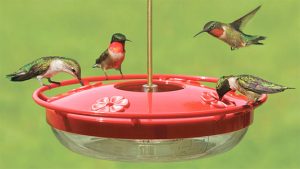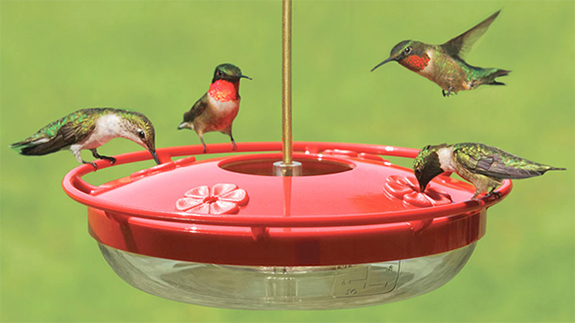How to be a good host for Ruby-throated Hummingbirds.
Spring Migration
In early Spring, start checking Hummingbirds’ migration on the Hummingbird Central Migration Map. In our area, they tend to arrive around Tax Day. (April 15th, or so.) We’re just guessing, but it’s likely everyone can agree that Hummingbirds’ arrival is a much nicer event to celebrate.
Nesting Season and Summer
If it seems like Nesting Season is a busy time at your Hummingbird feeders, just wait! Summer activity starts ticking up as nesting season’s juveniles begin joining their parents at your Hummingbird feeders. Don’t miss out on the joy of seeing awkward juveniles discovering your feeder for the first time.
Late Summer and Migration
Around mid-August, be ready to top up the nectar in your feeders even more frequently! In fact, you could see activity build to an all-out frenzy of feeding that will peak before Labor Day. While seeing Hummingbirds flocking around your feeder with such intensity is some of the season’s best backyard birding, it’s also a reminder that summer is winding down. Every Hummingbird is now bulking up in preparation for migration. It won’t be long before they’re all on their journey.
Fall Migration
Keep your Hummingbird feeder up with fresh nectar to support migrants passing through and don’t take it down until two weeks after you’ve seen your last visitor. We’ve had sightings as late as Halloween!
See our checklist below for tips on how you can attract and support these amazing, tiny travelers.
The Backyard Naturalist’s Tips For Attracting and Supporting Hummingbirds

The Hummzinger Highview.
FOOD! Keep Hummingbird Feeders Clean and Filled with Fresh Nectar
Are your Hummingbird feeders up to the job? The Backyard Naturalist is fully stocked with all the feeders, poles, nectars and accessories you could possibly need!
How to Place and Maintain a Hummingbird Feeder
- Think RED! Hummingbirds are attracted to the color red, both in the feeders and flowers they are attracted to.
- Use only clear nectar! Nectar in nature is clear, and you want to mimic their natural food sources. Never use red food dye! This is not appropriate for Hummingbirds.
- Make your own Hummingbird nectar.
It’s easy! See the recipe below. - Clean feeders and refresh nectar every few days, or sooner if not crystal clear. During hot weather, this should be done every other day generally.
- Use easy to clean, low maintenance, ant & bee proof feeders! We recommend the Aspects Hummzinger series of feeders as our favorites.
- Do not use soaps when cleaning your hummingbird feeders or nectar bottles! Cleaning with hot water is usually enough if you are being diligent, not letting mold develop. If needed, white vinegar is a safe cleaner and mixed with salt can be good as an abrasive.
- Hummingbird Wars?! Put out multiple feeders to reduce fighting. Hummingbirds in this area are known to be very territorial.
WATER! Add a Mister or Fountain to Your Bird Bath
Provide an enticing and safe water source. Not for drinking, so much, but definitely necessary for bathing to help remove sticky nectar residue from their feathers. Because your regular bird bath is likely too deep for tiny Hummingbirds, you could add rocks for them to perch on, but there’s an even better way! Adding a fountain, mister, dripper or sprinkler to your bird bath. As a bonus, the motion and sound of moving water also helps “advertise” your backyard bird bath for song birds.
SHELTER! Provide Nesting Material
When soft lichens Hummingbirds use to line their nests are scarce or unavailable, a Hummingbird Nesting Helper filled with material approved by The Hummingbird Society could help make your backyard a nesting destination.
HABITAT! Plant Flowers That Hummingbirds Love
Plant your garden with flowers that Hummingbirds love! We recommend and stock seeds for flowers that attract Hummingbirds, and also Bees, Butterflies and Songbirds.
These are all ways to increase your Hummingbird viewing opportunities while supporting these amazing birds!
Want more Hummingbird info?
Books we have on hand and recommend:
The Hummingbird Book by Donald and Lillian Stokes
Beginner’s Guide to Hummingbirds by Donald and Lillian Stokes
Wild Bird Guides: Ruby-Throated Hummingbird by Robert Sargent
Hummingbirds and Butterflies by Bill Thompson III & Connie Toops
Enjoying Hummingbirds More – Bird Watcher’s digest
A Dazzle of Hummingbirds by Bruce Berger
Watching Hummingbirds At Your Feeders?
Here’s Some Amazing Stuff to Ponder.
- The Ruby-throated Hummingbird beats its wings about 53 times a second.
- The extremely short legs of the Ruby-throated Hummingbird prevent it from walking or hopping. The best it can do is shuffle along a perch. Nevertheless, it scratches its head and neck by raising its foot up and over its wing.
- Scientists place Hummingbirds and Swifts in the same taxonomic order, the Apodiformes. The name means “without feet,” which is certainly how these birds look most of the time.
- Ruby-throated Hummingbirds prefer to feed on red or orange flowers. Like many birds, they have good color vision and can see into the ultraviolet spectrum, which humans can’t see.
- However, the Ruby-throated Hummingbird does not show a strong preference for any particular color of feeder. Instead, it prefers specific feeder locations.
- Ruby-throated Hummingbirds normally place their nest on a branch of a deciduous or coniferous tree; however, these birds are accustomed to human habitation and have been known to nest on loops of chain, wire, and extension cords.
- Ruby-throated Hummingbirds are eastern North America’s only breeding Hummingbird. But in terms of area, this species occupies the largest breeding range of any North American Hummingbird.
- Male Ruby-throated Hummingbirds don’t stick around long. Pairs are together long enough for courtship and mating – just a matter of days to weeks. Then he’s off on his own, and may begin migration by early August.
- The oldest known Ruby-throated Hummingbird was 9 years 1 month old.
Source: The Cornell Lab of Ornithology







